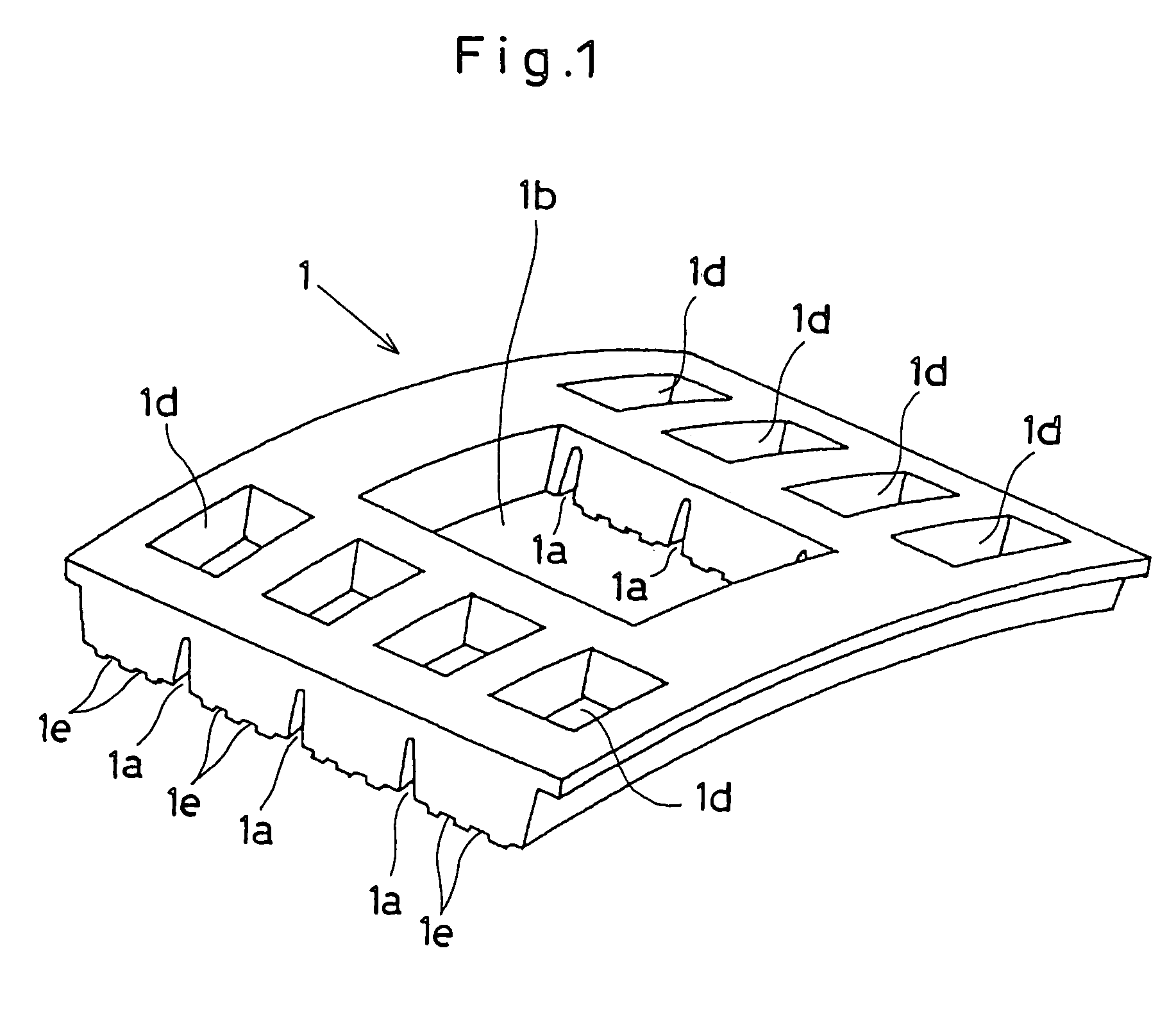Duct connection assemble between a branch duct and a main duct
a branch duct and duct connection technology, applied in the direction of pipe joints, pipeline expansion compensation, bends, etc., can solve the problems of water leakage at the connection between the saddle flange and the saddle flange, the adhesive agent may deteriorate and fall off the saddle flange, and the connection may be more prone to water leakage, so as to strengthen the engagement action
- Summary
- Abstract
- Description
- Claims
- Application Information
AI Technical Summary
Benefits of technology
Problems solved by technology
Method used
Image
Examples
first embodiment
[0042]Referring to FIGS. 1 through 8 which show the invention, a rubber sealant 1 has a rectangular contour and warped to have a radius corresponding to that of a saddle flange 2a provided on a lower portion of a joint duct 2 as shown in FIGS. 1 and 2. An inner surface of the rubber sealant 1 has streaks of narrow and long grooves 1a (e.g., 2 to 3 mm in width) with regular intervals (e.g., 3 to 8 ridges) along a main ribbed duct 3 so as to fit the grooves 1a to ribs 3a provided on the main ribbed duct 3 upon connecting the saddle flange 2a to the main ribbed duct 3.
[0043]Provided with a central area of the rubber sealant 1, is a communication hole 1b in correspondence to an upper opening 3b provided on the main ribbed duct 3 as shown in FIG. 3. Around periphery of the communication hole 1b, concentrically provided are streaks of water sealing small projective rings 1c (e.g., three ridges each 1 to 3 mm in breadth and height). Opposite to the side in which the grooves 1a are provided...
second embodiment
[0053]FIGS. 12 through 15 show the invention in which the rubber sealant 1 is simply formed into an annular ring configuration to be attached to a ribless main duct 3A, and a pair of plastic stopper plates 20 is provided to position in diametrically opposed location.
[0054]The stopper plate 20 has substantially an L-shaped cross section so that the stopper plate 20 is located at a vertical recess 25 provided on an inner wall of the branch duct 2c. A hook portion 20a forms an acute angle (θ) (e. g., 80 degrees among an angular range of 020B of the stopper plate 20 as shown in FIG. 14. A pin 21 is provided on both upper elevational sides of the stopper plate 20 in correspondence to a groove22 formed on an upper open end of the branch duct 2c as a pin-and-groove combination. An L-shaped cavity 23 is provided on both sides of the vertical wall 20B of the stopper plate 20 in correspondence to a pin 24 formed on the inner wall of the branch duct 2c. The cavity 23 is paired at right and lef...
fourth embodiment
[0060]FIGS. 17 and 18 show the invention in which the hook portion 20a is slightly warped downward to define a curved plane. A basal portion of the curved plane forms either an acute angle (020B of the stopper plate 20.
[0061]FIG. 19 shows a fifth embodiment of the invention in which the hook portion 20a has a stepped portion 20f along a breadth direction to define a slantwise plane 20g consecutively formed from a base plane 20j. The slantwise plane 20g is successively elevated upward toward a tip end 20h of the hook portion 20a. At the time of connecting the branch duct 2c to the main duct 3A in the same manner as described at the second embodiment in FIG. 15, the hook portion 20a engages the slantwise plane 20g with the inner edge 3s around the upper opening 3b so as to strengthen the engagement action. In this instance, the base plane 20j forms either an acute angle (020B of the stopper plate 20.
[0062]It is to be noted that a pair of the L-shaped cavities 23 is not confined to two...
PUM
 Login to View More
Login to View More Abstract
Description
Claims
Application Information
 Login to View More
Login to View More - R&D
- Intellectual Property
- Life Sciences
- Materials
- Tech Scout
- Unparalleled Data Quality
- Higher Quality Content
- 60% Fewer Hallucinations
Browse by: Latest US Patents, China's latest patents, Technical Efficacy Thesaurus, Application Domain, Technology Topic, Popular Technical Reports.
© 2025 PatSnap. All rights reserved.Legal|Privacy policy|Modern Slavery Act Transparency Statement|Sitemap|About US| Contact US: help@patsnap.com



